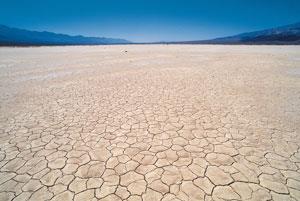Climate change is high on the agenda and the burden lies heavily on scientists to find new solutions, but do researchers have the support they need?
Climate change is hitting the headlines with increasing frequency as temperatures edge higher and politicians around the globe scramble to respond with effective policies. The burden lies heavily on researchers to come up with new solutions that will help the world move to a low-carbon economy and reduce our reliance on fossil fuels. But how realistic is the task scientists have been set? With the interface between science and policy not always an easy one, do researchers have the support they need to find new solutions and help stave off dangerous climate change?
2009 has been widely touted as a make or break year for global efforts to tackle climate change. Global warming was high on the agenda at the recent meeting of the major economies in Italy, and December will see the hotly anticipated United Nations climate change conference in Copenhagen, at which international bodies will try to agree on an ’ambitious and effective’ strategy to combat climate change.

The United States is one of the world’s greatest emitters of greenhouse gases; in 2007 the country generated over 7 billion tonnes of carbon dioxide equivalents. Following the nation’s failure to ratify the Kyoto Protocol in 1997, and former president George W Bush’s reluctance to commit to binding climate change measures, the recent change in US administration has been seen as hugely important in international negotiations on actions to tackle climate change.
Robert Marlay, deputy director of climate change policy and technology at the US Department of Energy, believes the new administration has reinvigorated the country’s attitude to climate change: ’With the change of administration the United States has embraced very ambitious goals and are willing to do everything within our means to move in that direction as rapidly as possible,’ he told Chemistry World. ’There’s a sense of urgency about bringing on new solutions that are affordable much more quickly and I think this is represented in discussions at the G8 and the Major Economies Forum.’
This renewed urgency has been welcomed by other major nations, including the UK - another major greenhouse gas emitter, generating over 600 million tonnes of carbon dioxide equivalents in 2008 with a population a fifth that of the US.
We’ve now got a US administration which has got science and technology at the very highest level,’ the UK’s chief scientific adviser John Beddington told Chemistry World. And all the indications are that the Obama White House is taking climate change seriously and recognising the scientific evidence, he adds.
Back to basics
Basic research plays a significant role in the US’ proposals to tackle global warming. If passed as requested, the 2010 budget will devote around $5.5 billion (?3.3 billion) to work on technologies and basic research to reduce greenhouse gas emissions.
’Basic research is critical,’ says Marlay. ’If we could simply engineer modest improvements to existing technologies we would have already done it.’ Marlay’s department sees the chemical sciences as a field that has a lot to offer in terms of developing new ways to reduce carbon dioxide emissions, specifically highlighting catalysis, photochemical energy conversion, electrical energy storage and electrochemical interfaces as potentially fruitful areas of research.
Energy storage is an area where Marlay believes basic research could help in the transition from petroleum-based transport to alternatives with a smaller carbon footprint. ’In basic research we have carbon nanotubes and graphene plates - both of these are atomic layer thicknesses which can attract electrons to their surfaces, and this would create an enormous surface in a small place,’ he says. ’If that could be tapped in some way to become a super-ultra capacitor, that would possibly be a breakthrough in energy storage.’
This emphasis on the importance of basic research is echoed by scientists. Daniel Zajfman, president of the Weizmann Institute of Science in Israel, warns that just because answers to the climate change problem are needed, doesn’t mean they will be found - and argues that directing research is not the solution.
’Not a single politician ever stood on a podium and said "we need a revolution in electronics - let’s discover the transistor,"’ said Zajfman at a recent meeting on energy and environment in London, UK. ’These technologies were not born because we needed them or made a statement about their use - they were born out of curiosity, because scientists were looking at the basic behaviour of nature, trying to discover how it works.’
’We need to invest in scientific research at the most basic level, with the top people, and have more people going into science so more people can tackle these issues.’
Here and now
Carbon capture and storage (CCS) is seen as a front-runner in terms of a relatively ’quick win’ to start reducing greenhouse gas emissions, with pilot plants beginning to spring up around the world to bury carbon dioxide underground and prevent it escaping to the atmosphere.
’Development of photovoltaics, thin films and so on are real opportunities, but the be all and end all of technology is carbon capture and storage,’ says Beddington. ’Coal is going to be used. We’ve got to work out ways of dealing with coal in a clean way, in a non-carbon emitting way, whether that’s carbon capture and storage or other technologies.’
Others, however, see CCS merely as a transition technology - one that should only be used in the short-term while researchers work to find entirely new sources of energy. Renowned chemist James Barber, who has spent many years uncovering the secrets of photosystem II (the mechanism by which plants use light to split water into oxygen, protons and electrons), believes new directions need to be considered as science grapples with the challenges of energy supply and climate change.
’Whatever we do in terms of efficiency saving, as the population of the world grows, the amount of energy required will double by the year 2050 or so,’ Barber explains. Pumping carbon dioxide underground is ’a silly, primitive thing to do’ in his eyes; new science is the way to truly tackle climate change.
’There is chemistry in the biological world that captures carbon dioxide and turns it back into high energy carbon-based compounds,’ says Barber. ’We must invest in basic research to develop the catalytic systems to be able to get into a cyclic process of converting the CO2 that we generate back into carbon rich compounds.’

Two degrees of freedom
In 2007 the Intergovernmental Panel on Climate Change (IPCC) recommended that global warming be kept to no more than 2?C above pre-industrial temperatures (that’s around 1.2?C higher than today) to avoid dangerous consequences from climate change. This figure, however, is already being questioned, as the latest evidence suggests that it simply won’t be enough to curb the effects of global warming.
’You’re seeing it in terms of CO2 emissions, the decline of the Greenland ice caps, the decline of Arctic sea ice,’ says Beddington. The IPCC report included data through to 2004; the picture painted by more recent data is, if anything, worse, he says.
Marlay, however, thinks the 2?C target will be hard enough to achieve, let alone any stricter limits. ’If you look at all that we know today it would seem to be a very challenging target that perhaps is beyond our means from an affordability point of view,’ he says. ’On the other hand, the consequences appear to be very large, which would justify a major investment.’
But Marlay does remain optimistic about the potential of science to turn the game around. ’Research and development can have breakthroughs that change paradigms,’ he says. ’If we had some really good work in the next five or ten years, there would be enough time to deploy that technology in such a way that we could accelerate the reduction of emissions very rapidly.’

Upping the pressure
While climate change is undoubtedly high on the agenda, it will be at the United Nations meeting in Copenhagen later this year that all the talk will have to be converted to action. It is here that a deal of historic significance will (hopefully) be thrashed out over two weeks as representatives from 192 countries around the globe put together a successor to the Kyoto Protocol.
The global nature of the climate change offers both opportunities and challenges. The US, for example, is keen to establish international cooperation and collaboration in climate change research, says Marlay. But developing countries are in a very different position to the developed nations, and have different outlooks and priorities that could prove a significant sticking point in Copenhagen.
’The developed world has had the benefit of using fossil fuels over a long period of time, and the developing world has not,’ explains Beddington. ’There are therefore equity problems which have the potential for presenting real problems [in Copenhagen].India and China particularly are so large and are producing so much greenhouse gas that there needs to be some mechanism which is satisfactory to all parties.’
The pressure on those sitting around the table in December is sizeable - their actions will dictate the extent of the damage the world avoids - and suffers - as a result of climate change. But it is those further down the chain, in the labs and research institutes around the world, who will be working on the practical solutions that the world needs to adapt and survive in the face of climate change.
’This is probably one of the most exciting times to work in research - you have enormous support from national governments, from international regimes, from the population in general,’ says Marlay. ’It may be awkward for people to think about making sacrifices [in the face of climate change], but it’s inspiring to think about what technology can do to help.’
Anna Lewcock
Interesting? Spread the word using the ’tools’ menu on the left.
Also of interest
Climate conference updates IPCC findings
Scientists present policymakers with the latest climate change research







No comments yet